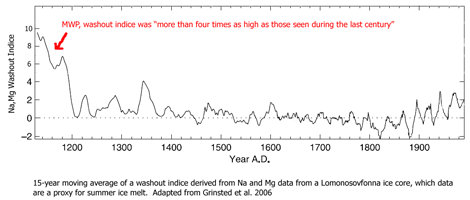Lomonosovfonna Ice Core, Svalbard, Norway
Reference
Grinsted, A., Moore, J.C., Pohjola, V., Martma, T. and Isaksson, E. 2006. Svalbard summer melting, continentality, and sea ice extent from the Lomonosovfonna ice core. Journal of Geophysical Research 111: 10.1029/2005JD006494.
Reference
Grinsted, A., Moore, J.C., Pohjola, V., Martma, T. and Isaksson, E. 2006. Svalbard summer melting, continentality, and sea ice extent from the Lomonosovfonna ice core. Journal of Geophysical Research 111: 10.1029/2005JD006494.
Description
From data obtained from a 121-meter-long ice core they extracted from the highest ice field in Svalbard (Lomonosovfonna: 78°51'53"N, 17°25'30"E), Grinsted et al. developed "a model of chemical fractionation in ice based on differing elution rates for pairs of ions ... as a proxy for summer melt (1130-1990)," which was "validated against twentieth-century instrumental records and longer historical climate proxies." This work revealed, in their words, that "the Medieval Warm Period in Svalbard summer conditions [was] as warm (or warmer) as present-day," because "the degree of summer melt was significantly larger during the period 1130-1300 than in the 1990s."





